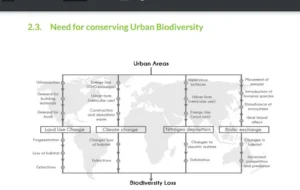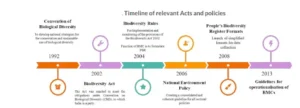Introduction
- Urban biodiversity in India is significantly declining due to rapid urbanization and environmental degradation.
- Bengaluru, once renowned as ‘India’s Garden City,’ is now becoming a concrete jungle, with urban forests, orchards, and agricultural fields giving way to concrete structures, adversely affecting local biodiversity.
- Similar patterns of biodiversity loss are observed in other major cities such as Delhi, Hyderabad, and Mumbai.
Urban Biodiversity
- Biodiversity – Biodiversity is typically a measure of variation at the genetic, species, and ecosystem level. Can be termed as “the variety and variability of life on Earth.”
- Urban Area – An urban area, or built-up area, is a human settlement with a high population density and infrastructure of built environment. Mostly, a town, suburb or a city.
- Urban Biodiversity: It refers to the variety of living organisms, including plants, animals, and microorganisms found within urban areas, and the interactions among them in city environments. It encompasses the genetic, species, and ecosystem diversity present in cities and their surroundings.
Read also: Space Sector in India: Major Achievements and Future Goals | UPSC
Examples of Well-Maintained Urban Biodiversity in India
- Chennai: The restoration and maintenance of wetlands like Pallikaranai Marsh have led to increased biodiversity. These wetlands provide habitat for various bird species, amphibians, and aquatic plants, promoting ecological balance.
- Delhi: The Delhi Ridge acts as a green lung, supporting a variety of flora and fauna. Initiatives for protecting and enhancing this area help maintain native species amid urbanization pressures.
- Mumbai: The Sanjay Gandhi National Park and coastal areas, including mangroves, contribute to Mumbai’s rich biodiversity. These green spaces play a crucial role in maintaining ecological health within the city.
Global Examples of Well Maintained Urban Biodiversity
- Toronto: It is a prime example of a city at the forefront of environmental sustainability, urban tree health, and built-environment biodiversity. The Toronto Green Standard is an evolving set of guidelines, instituted in 2006, used as a framework for prioritizing sustainability in new city developments and retrofits.
- Singapore: Its extensive green infrastructure, including vertical gardens, green roofs, and parks, supports a diverse range of plant and animal species, making it a model for urban biodiversity.
- Colombia: In Medellin, Colombia, a network of green corridors has been developed, resulting in cleaner air and a two-degree reduction in city temperature.
- Vancouver: It has adopted policies to protect its natural areas and promote biodiversity throughout the city.
Role of Urban Biodiversity
Provisioning Services:
-
-
- Water, food, wood and other goods are some of the material benefits people obtain from ecosystems called ´provisioning services´. In many regions, rural households also directly depend on provisioning services for their livelihoods.
- For instance, Pashan Lake in Pune serves as a crucial freshwater resource for the surrounding urban areas and supports activities like fishing and irrigation for nearby urban farming communities.
-
Regulating Services:
-
-
- Maintaining the quality of air and soil, providing flood and disease control, or pollinating crops are some of the ‘regulating services’ provided by ecosystems. When they are damaged, the resulting losses can be substantial and difficult to restore.
- They help monitor local air quality through intercepting smoke particulate pollutants (dust, ash, pollen and smoke) and absorbing toxic gases such as ozone, Sulphur dioxide, and nitrogen dioxide.
-
Cultural Functions:
-
-
- The non-material benefits people obtain from ecosystems are called “cultural services”.
- For instance, coral reefs, such as those in the Andaman and Nicobar Islands, are vital for tourism, providing opportunities for recreational activities like snorkeling and diving.
-
Supporting Functions:
-
-
- Providing living spaces for plants or animals and maintaining a diversity of plants and animals, are ‘supporting services and the basis of all ecosystems and their services.
- For example, tropical rainforests, such as the Amazon Rainforest provide living spaces for a vast diversity of plants and animals, maintaining essential biodiversity.
-
Need for Conservation of Urban Biodiversity
Rising Carbon Emissions:
-
-
- Urban areas account for nearly three-fourths of global greenhouse gas emissions, according to the World Economic Forum (WEF). This makes biodiversity conservation crucial as urban green spaces act as carbon sinks.
- For instance, cities like Delhi, Mumbai, and Bengaluru contribute significantly to emissions due to industrialization, vehicular pollution, and rapid urban expansion.
- According to the World Air Quality Report 2023 by IQAir, Delhi ranked as the most polluted capital city in the world, with PM2.5 levels averaging 92.7 µg/m³. This report highlights a 10% increase in Delhi’s particulate matter concentrations compared to the previous year, reversing earlier improvements.
-

Economic Risks from Biodiversity Loss:
-
-
- The 2023 World Economic Forum (WEF) Global Risks Report, which highlights that nearly 44% of global GDP—approximately $31 trillion—is at risk due to biodiversity loss and the consequent disruption of ecosystem services.
- For instance, the 2020 floods in Chennai were exacerbated by the destruction of the Pallikaranai Marshland. The floods disrupted businesses, resulted in significant economic losses (estimated at $3 billion).
-
Urban Heat Island Effect (UHI):
-
-
- Urban areas with reduced green cover, high concrete density, and insufficient natural cooling mechanisms lead to the creation of Urban Heat Islands (UHIs).
- Temperatures in Delhi’s Mungeshpur reached a record-breaking 52.3°C in 2024, the highest ever recorded in the city. Over 300 lives have been lost due to heatwaves across India this summer.
- The Indian Institute of Tropical Meteorology highlighted a 30-40% increase in areas experiencing heat stress in India over the last 70 years, further intensifying the UHI effect, particularly in densely populated and poorly ventilated urban areas.
-
| The urban heat island (UHI) effect, a phenomenon where urban areas experience significantly higher temperatures than their rural counterparts.
The UHI effect is primarily driven by human activities and urbanisation, which replace natural landscapes with dense concentrations of buildings, roads, and other infrastructure. These materials, such as concrete and asphalt, absorb and retain heat more effectively than natural landscapes, causing urban temperatures to rise, particularly at night. In cities, buildings with dark surfaces have a lower albedo, meaning they reflect less sunlight and absorb more heat, exacerbating the temperature increase. The construction of closely built structures further compounds this issue by limiting airflow, creating pockets where heat becomes trapped and temperatures soar. |
- Decreased Disaster Resilience: Unplanned urban expansion often leads to the destruction of natural ecosystems, which play critical roles in disaster mitigation.
-
- The encroachment of the Mithi River in Mumbai contributed to the devastating floods in 2005, when the river could not handle the heavy rainfall due to urban development around it.
-
Benefits of Well-Maintained Urban Biodiversity
Ecological Benefits:
-
-
- Urban Heat Island Mitigation: Green spaces like Delhi’s Ridge and Mumbai’s Sanjay Gandhi National Park reduce temperatures by acting as natural cooling systems, mitigating the Urban Heat Island effect and improving air quality.
- Carbon Sequestration: The Aravalli Biodiversity Park in Gurgaon sequesters carbon by absorbing large amounts of CO₂, contributing to a reduction in the overall carbon footprint of the urban area.
- Increased Biodiversity: Pashan Lake in Pune serves as a prime example of well-maintained urban biodiversity. The lake is a critical habitat for over 40 species of migratory and resident birds, including the endangered Indian Spot-Billed Duck.
- Urban Hydrological Cycle Management: Green spaces aid in water filtration, recharge, and regulation, supporting sustainable urban water management. The East Kolkata Wetlands act as a natural filtration system, processing the city’s wastewater and helping recharge groundwater, contributing to sustainable water management.
-
Social Benefits:
-
-
- Controlling Unplanned Urbanization: Urban green spaces demarcate city limits and industrial zones, preventing the spread of slums and unchecked development. The Nehru Park in New Delhi demarcates urban boundaries, preventing further encroachment and limiting unchecked slum development in surrounding areas.
- Aesthetic and Recreational Value: Green spaces enhance the visual appeal and livability of cities. For example, Hyderabad won the ‘World Green City Award 2022’ for its green initiatives.
- Improving Mental Health: Green areas provide residents with stress relief and improve physical and mental well-being by offering natural spaces for relaxation and interaction. The Cubbon Park in Bengaluru offers a green retreat for the city’s residents, providing stress relief and improving physical and mental well-being through recreational activities.
- Educational Spaces: Urban forests serve as educational centers for learning about flora and fauna through parks, botanical gardens, and zoos. The Botanical Gardens of Ooty serve as an educational hub for students and researchers, offering insights into diverse plant species and ecological processes.
- Cultural Regeneration: Green spaces support local cultural events, festivals, and public gatherings. For example, festivals like the Vat-savitri pooja are celebrated in urban areas of Bihar.
-
Economic Benefits:
-
-
- Increased Property Values: Green landscaping in urban areas boosts real estate prices by enhancing the appeal of residential and commercial spaces. For instance, properties near Central Park, Kolkata have witnessed increased real estate values due to the presence of well-maintained green spaces that enhance the appeal of the area.
- Job Creation: Urban afforestation projects generate employment for local communities, particularly for the urban poor. For instance, the Nagar Van Udyan Program, which promotes urban forestry across India, creates jobs for local communities by engaging them in planting and maintaining trees.
- Reduced Energy Consumption: Trees and green cover help in reducing the need for air conditioning, lowering energy consumption in urban areas. For instance, in Chennai, increased tree cover in urban spaces has led to reduced demand for air conditioning, significantly cutting energy consumption in residential and commercial areas.
-
Read also: Urban Heat Island | UPSC
Initiatives for Increasing Green Cover in Urban Areas
- Nagar Van Udyan Program: Aims to develop 200 Nagar Vans (City Forests) across India, involving local communities and organizations to maintain urban forests.
- Smart Cities Mission: Incorporates green cover enhancement into urban planning as part of India’s Smart Cities initiative.
- National Mission for Green India: Focuses on increasing tree cover and improving the quality of urban forests under the National Action Plan for Climate Change (NAPCC).
- Urban Afforestation Programs: Cities like Pune have launched projects such as the Urban Forest Garden Project, using methods like the Miyawaki technique to increase urban tree cover.
- Urban Greening Guidelines: Issued by the Ministry of Housing and Urban Affairs, these guidelines set standards for maintaining a minimum green cover of 12-18% in urban areas.

Way Forward
- Reintegration of Nature in City Planning: Cities should incorporate natural habitats and community-based tree planting in urban development.
- Reintroduction of Native Plants: Protecting forests and reintroducing native species can restore ecosystems to their original state.
- Systems Approach to Governance: Urban governance should integrate natural ecosystem values, considering the needs of all stakeholders for sustainable development.
- Creation of Green Corridors: Green corridors, like those in Medellin, Colombia, can mitigate climate change effects and promote biodiversity in urban settings.
- Attracting Investments: Cities should frame nature as an attractive investment opportunity for private funding, promoting sustainable urban ecosystems.

